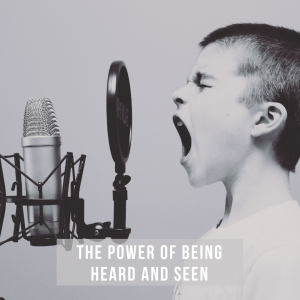
When I was younger, there was a saying that went something like this, ‘children are to be seen and not heard.’ It was a belief that people had and it was drilled in by ‘well-meaning’ parents. It was usually put into place when parents were entertaining or, perhaps when their children became a little annoying. Thankfully, in our family, my parents didn’t adopt this way of thinking or parenting.
This was a saying that applied in many families and it seems to have been one that was globally recognised and welcomed by many. Good parents at that.
As I’ve grown over the years, struggled with my own insecurities in school due to my dyslexia, raising my own children and now have the privilege of being a grandparent, plus the work we do with Little Miracles, I’ve come to know that children need to be seen, absolutely and to be heard
Here are just a few ideas to help you let your children know that they are heard and seen:
- Set aside time in the day to connect whether that be a morning snuggle on the lounge before the day begins, at the dinner table with no tech distractions and full eye contact or a book before bedtime.
- Be prepared to get down to their level and look them in the eye. Even hold their face in your hands to let them know you are fully engaged.
- Be open to talking about all kinds of feelings whether it be anger, joy, frustration, sadness, fear and anxiety. Be honest about your feelings.
- Be aware of their body language. Psychology Today shared a very good article by Jeff Thompson, Ph.D., who is a crisis communication researcher and trainer and is a professor at New York University. The article talks about the breakdown of our non-verbal, tone of voice and actual words spoken and how the combination makes up our communication.
- Slow down. Life is so busy right now and we are bombarded with things that grab our attention. If time is tight then make every bit count. For example, when you’re driving, turn the radio off and avoid taking any calls. Be present and engaged with your child who is sitting next to you or in the back seat. Use the time wisely. If you’re making dinner, invite your child in to join you. It’s amazing how much you will learn whilst listening and doing something as simple as preparing dinner.
- Eye contact is a must. This is something we need to teach by example and in the digital world we live in, eye contact is something that is falling by the wayside at the speed of light.
- Avoid talking over. Let them finish their sentences and do your best not to cut them off. This is particularly challenging when a story is going on and on or if you’re listening to teenagers try and correct you. Be patient and breathe knowing that their thoughts and ideas are valuable.
To be heard and seen is something we all desire, it’s human nature to be wanted to be valued in such a way and it’s a gift we are able to give one another, especially our children. Lastly, in a time where anxiety and depression are on the increase, our need to be present, to hear and to see is even greater. Beyond Blue adds weight to this conversation and serves as a good reminder to all – they even remind us (adults) the things we can learn from our children. Life certainly is a two-way street. May we all walk with confidence, love whilst hearing, seeing and celebrating one another. Much love and respect, Susanna #littlemiraclescommunity


